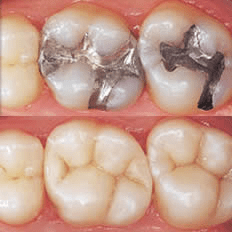 We’ve all seen those articles that promise to tell you all about how your dentist might be “ripping you off.” Most of them include a more or less dire warning against dentists who recommend getting your mercury amalgam “silver” fillings replaced. It’s a standard topic point, courtesy of the ADA and dentists who aren’t yet informed of the vast evidence that dental amalgam is a hazard to human health.
We’ve all seen those articles that promise to tell you all about how your dentist might be “ripping you off.” Most of them include a more or less dire warning against dentists who recommend getting your mercury amalgam “silver” fillings replaced. It’s a standard topic point, courtesy of the ADA and dentists who aren’t yet informed of the vast evidence that dental amalgam is a hazard to human health.
So there we were, confronted by yet another of these pieces, anticipating the ADA clichés…and they never came. What the article did say was this:
Dentists also tend to fail to counsel patients on the benefits and risks of different types of fillings, some of which contain mercury.
Yes, they do. According to a 2014 Zogby poll, only 11% of patients report having been told by their dentist that amalgam fillings are mostly mercury. And 66% believe their dentist doesn’t provide them with enough information about alternatives to mercury to make an informed decision.
Unsurprisingly more than half of Americans still don’t know that mercury is the main component of “silver” fillings.
The article didn’t say anything about why mercury is a concern, but it didn’t have to. The fact that they pointed out the lack of informed consent regarding amalgam strongly says that it’s worth being concerned about.
Amalgam fillings constantly off-gas mercury vapor, mere inches from the brain. Mercury is one of the most toxic elements there is. There is no safe level of exposure. The body excretes what it can, but inevitably, some mercury will come to be stored in organs such as the liver, kidneys, and brain.
To say that mercury amalgam is “safe” is a lie. Withholding information about its risks is just as much a lie – a sin of omission rather than commission.
Although some people continue to insist that there’s a “controversy” over mercury amalgam, the reality is that science has delivered sufficient evidence to put that claim to rest. The industry has been moving away from the material for years, especially as more and more good, biocompatible alternatives have become available. Politically, too, we’re now bound under the Minamata Convention to work toward a phase-out of this toxic dental material.
Nothing controversial there.
Yes, the article does warn more generally to “watch out for dentists who insist on replacing all of your old fillings.” But that’s not an unfair warning, especially if the dentist doesn’t give good reason to replace those fillings, regardless of type. There are, after all, some people who can have one or two amalgams and suffer no significant consequences, particularly if they’re dealing with no other health burdens.
Even so, they may still choose to have the fillings replaced once they learn of the risks, wanting to minimize all exposure to toxins for the sake of their long-term health.
And that’s whose decision mercury removal ultimately is: the individual patient’s.
We can and do educate our patients about the scientific evidence against mercury fillings. We can and do evaluate them fully to see whether their amalgams – or root canal teeth or other problem dental situation – may be playing a negative role in their overall health (and refer them out for additional evaluations as needed or appropriate).
What we don’t do is say, “You MUST have all of your amalgam’s replaced.” That’s the antithesis of the health freedom we cherish – freedom which stands on the foundation of informed consent.
It’s your right as a patient to know what’s harming or could improve your health, and the pros and cons of all appropriate treatment alternatives. You are the one to then make the choice as to whether and how to proceed – a choice based on your goals, values, needs, and priorities.
You are the director of your own health and well-being. Being denied that role is the real ripoff.